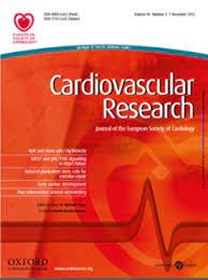由人类环状RNA circSLC8a1编码的一种新的蛋白异构体有助于心脏重塑
IF 10.2
1区 医学
Q1 CARDIAC & CARDIOVASCULAR SYSTEMS
引用次数: 0
摘要
环状RNA circSLC8a1先前被认为具有翻译潜力,但缺乏支持这一观点的实验证据。我们的目的是了解circSLC8a1及其翻译蛋白在心脏重构中的功能。方法与结果为了阐明circSLC8a1的功能意义,我们建立了表达circSLC8a1及其翻译蛋白SLC8a1-604的转基因小鼠系。我们提出了令人信服的证据,证实了circSLC8a1 (hsa_circ_0005232)在体外和体内的翻译潜力。hsa_circ_0005232内的反向剪接事件导致产生一种新的circrna衍生蛋白,包含604个氨基酸,命名为SLC8a1-604,此前未见报道。这些SLC8a1-604转基因小鼠表现出心力衰竭表型。在进一步的研究中,我们在转基因小鼠中诱导了压力过载,发现与窝仔匹配的阴性对照相比,心脏功能显著下降。值得注意的是,我们的研究结果表明,在转基因小鼠中观察到的心脏功能下降可归因于circRNA翻译蛋白SLC8a1-604的存在,而不是circRNA本身。在机制上,我们发现SLC8a1-604转运到线粒体,在那里它通过与POLRMT结合发挥作用。这种相互作用导致线粒体基因转录下调,导致ATP合成减少。我们的研究证明circSLC8a1具有编码一种新的蛋白异构体SLC8a1-604的能力,该蛋白异构体在心脏功能的调节中起着关键作用:circSLC8a1通过翻译成一种功能性蛋白来调节心脏压力过载的重塑过程。这项概念验证研究可能为环状RNA治疗的潜在临床应用奠定基础。本文章由计算机程序翻译,如有差异,请以英文原文为准。
A new protein isoform encoded by human circular RNA circSLC8a1 contributes to cardiac remodeling
Aims Circular RNA circSLC8a1 has been previously suggested to possess translation potential, but experimental evidence supporting this notion has been lacking. We aim to understand the functions of circSLC8a1 and its translated protein in cardiac remodeling. Methods and Results To elucidate the functional significance of circSLC8a1, we established a transgenic mouse line expressing circSLC8a1 and its translated protein SLC8a1-604. We present compelling evidence confirming the translation potential of circSLC8a1 (hsa_circ_0005232) both in vitro and in vivo. The back-splicing event within hsa_circ_0005232 leads to the generation of a novel circRNA-derived protein comprising 604 amino acids, named SLC8a1-604, which has not been previously reported. These SLC8a1-604 transgenic mice exhibited a heart failure phenotype. In further investigations, we induced pressure overload in the transgenic mice, revealing a significant decrease in heart function compared to litter-matched negative controls. Notably, our findings indicate that the reduced heart function observed in the transgenic mice can be attributed to the presence of the circRNA-translated protein, SLC8a1-604, rather than the circRNA itself. Mechanistically, we found that SLC8a1-604 translocated into mitochondria, where it exerted its effects by binding to POLRMT. This interaction results in a downregulation of mitochondrial gene transcription, leading to a decrease in ATP synthesis. Conclusion Our study provides evidence that circSLC8a1 has the capacity to encode a novel protein isoform, SLC8a1-604, which plays a pivotal role in the regulation of heart functions: circSLC8a1 modulates the remodeling process of cardiac pressure overload by translating into a functional protein. Translational Perspective This proof-of-concept study may lay the foundation for potential clinical applications in circular RNA therapy.
求助全文
通过发布文献求助,成功后即可免费获取论文全文。
去求助
来源期刊

Cardiovascular Research
医学-心血管系统
CiteScore
21.50
自引率
3.70%
发文量
547
审稿时长
1 months
期刊介绍:
Cardiovascular Research
Journal Overview:
International journal of the European Society of Cardiology
Focuses on basic and translational research in cardiology and cardiovascular biology
Aims to enhance insight into cardiovascular disease mechanisms and innovation prospects
Submission Criteria:
Welcomes papers covering molecular, sub-cellular, cellular, organ, and organism levels
Accepts clinical proof-of-concept and translational studies
Manuscripts expected to provide significant contribution to cardiovascular biology and diseases
 求助内容:
求助内容: 应助结果提醒方式:
应助结果提醒方式:


